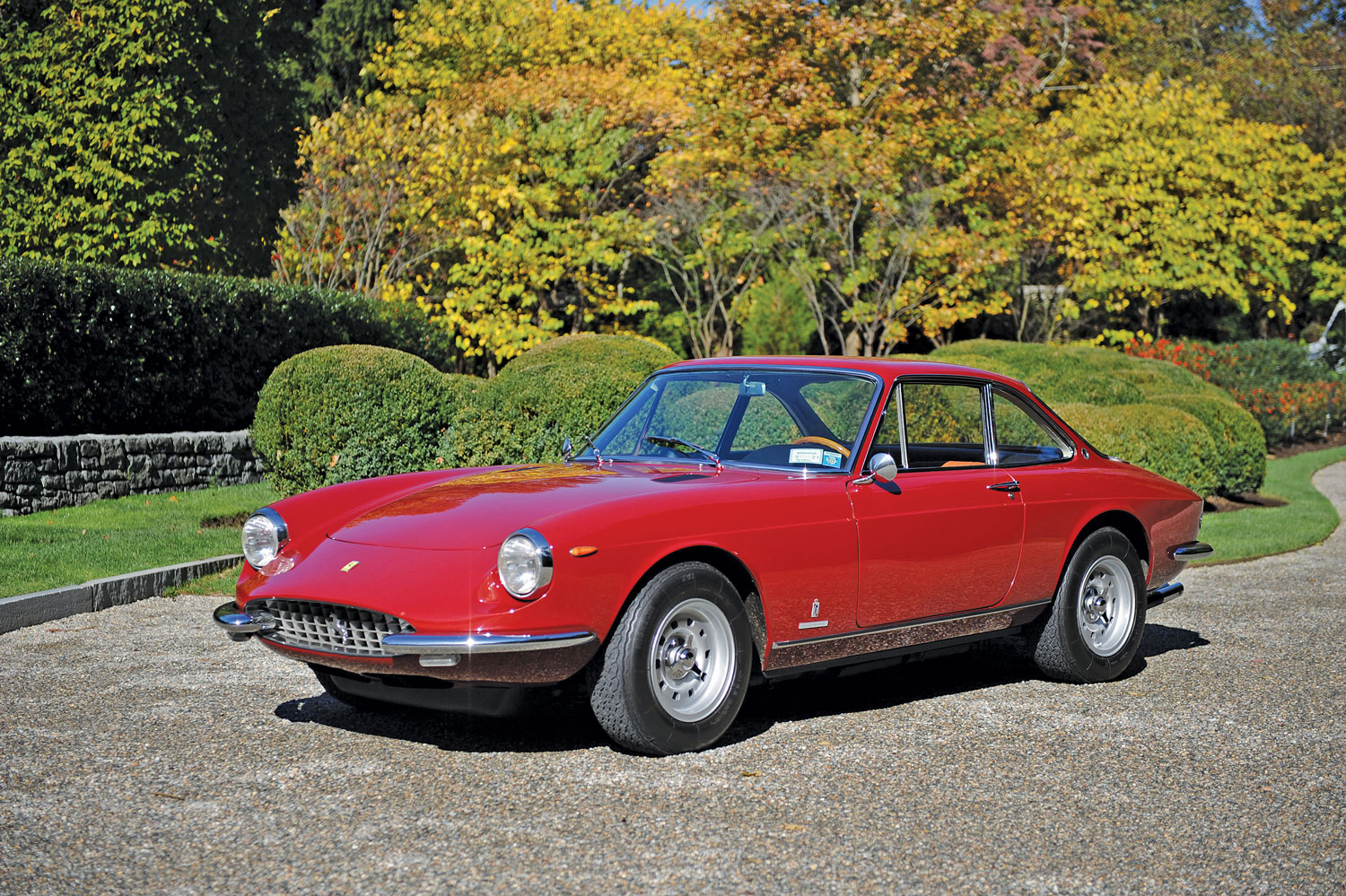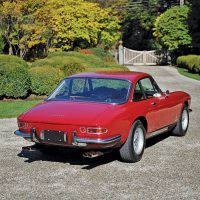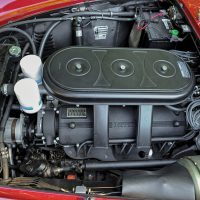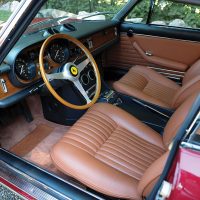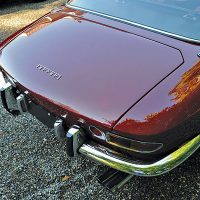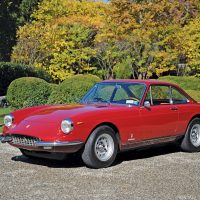SCM Analysis
Detailing
| Vehicle: | 1969 Ferrari 365 GTC |
| Years Produced: | 1968–70 |
| Number Produced: | 168 |
| SCM Valuation: | $686,000 |
| Chassis Number Location: | Stamped on the chassis near the right front shock absorber |
| Engine Number Location: | On a lug on the right rear side of the engine block |
| Club Info: | Ferrari Club of America |
| Website: | http://www.ferrariclubofamerica.org |
| Alternatives: | 1973 Ferrari 365 GTB/4 Daytona, 1970 Aston Martin DBS V8, 1969 Lamborghini Islero S |
| Investment Grade: | B |
This car, Lot 2053, sold for $660,000, including buyer’s premium, at RM Sotheby’s Online Only Open Roads Fall sale, on November 20, 2020.
Can a 10% increase in engine displacement really add 20% more value to a car? It does not take the Geico gecko to answer that question.
Throughout automotive history, manufacturers have used horsepower to upsell clients. Higher horsepower equals more profit, whether it is used to draw a client to a premium edition or add life to an aging model. When the horsepower goes up, so does the price.
A Ferrari 330 GTC and a Ferrari 365 GTC are nearly identical cars. While they may look the same, the 365 will indeed command a 20% premium over the 330. That bump in displacement and power takes the credit for the extra dollars.
Ferrari’s coupe lineage
In 1958, Ferrari introduced a new road-car series that offered the performance of a Ferrari berlinetta in a more comfortable configuration. The 250 GT Pinin Farina coupe was the first car in the series. The 250 Lusso replaced the PF coupe, and the 330 GTC replaced the Lusso when the 250 series was phased out. Then, the 365 GTC replaced the beloved 330.
Sharing the showroom with Ferrari’s 3.3-liter 275 GTB/GTS and its 4.0-liter 330 2+2, the 330 GTC blended the 275 GTS styling with the 330 2+2’s engine.
A 275 GTB may be the quintessential Ferrari design, but the 330 GTC has the shape many find more appealing. The 275 GTB screams “look at me!” while the conservative GTC whispers that the owner has good taste. The 275 GTB and the 330 GTC were both designed by Pininfarina but built by different carrosseries. The GTB was built by Scaglietti, famous for building bare-bones Ferrari race cars. The GTC was built by Pininfarina, known for its high quality and premium features. Pininfarina’s touch is evident throughout the GTC.
Mirroring the 330 GTC profile, the 365 GTC’s body differs in just two details. The 330 has both a “Ferrari” and a “330” badge on the trunk lid, while the number was scrapped for the later model. Pininfarina also replaced the front fender air vents of the 330 GTC with small plastic grilles on each side of the hood of the 365. The new vents improved air management but also sucked brake fluid out of the reservoir at high speed. (A makeshift reservoir shield has been fitted to our subject car to alleviate the problem.)
More displacement, more torque
Ferrari nomenclature tells us the 365 GTC’s engine has 365 cc of displacement per cylinder for 4.4 liters of total displacement. The 330 GTC has 330 cc of displacement per cylinder, making it a 4.0-liter engine. The difference in size is small, but the difference in performance makes a great Ferrari a near-perfect one.
Ferrari’s 365 engine was introduced in the 365 P prototype race car, and Ferrari continued the 365 engine in several configurations. Each configuration used the same 81-mm bore and 71-mm stroke but differentiated with 2-cam and 4-cam heads, and variations of carburation. The final version of the 365 engine was the flat 12 used in the 365 Berlinetta Boxer.
The 365 GTC’s V12 engine features single overhead cams with three Weber carburetors. The output is 320 hp, 20 more than the engine it replaced in the 330. More importantly, the increased displacement gave the 365 engine more torque at lower rpms. This version would be the last single-overhead-cam engine offered by Ferrari.
I called a friend to fact-check a 365 feature. He has previously owned a 330 GTC and currently has both a 365 GTC and an ultra-rare open-top 365 GTS. Before I could even get my question out, he went on an enthusiastic rave about the virtues of the 365 GTC. He followed his dissertation by noting he had driven his 365 GTC just the weekend before. He thought it may be the best-driving Ferrari he has owned, crediting the extra torque for making the 365 a much more enjoyable car than the 330. He found it an exceptional around-town car and an extraordinary highway cruiser; his comments echo the conventional wisdom about the model.
No reason not to drive it
Our subject Ferrari has a known history with no warts. It has been professionally refurbished and comes with a Ferrari Classiche Red Book, records and a Massini Report. It is not up to Pebble Beach standards, but that is not a bad thing. The nicest 365 GTC on the planet is not going to win a major concours; they simply do not have the “wow factor” of a big winner. On the other hand, they are exceptional drivers. Instead of chasing trophies, 365 GTC owners can drive their cars without worrying about losing a concours point.
The car was previously featured at RM Sotheby’s 2016 Monterey auction (SCM# 6809475), where its pre-sale estimate of $750,000–$850,000 confirmed that the market was on a decline. A year earlier, the mean sales price of a 365 GTC was more than $900,000. So when the car sold post-auction for $682,000, it was a shock to everyone following the Ferrari market.
This time around, last November, the $625,000–$675,000 pre-sale estimate correctly predicted the $660,000 sale and indicates confidence in the stability of current values.
The best automotive investment is the one that brings you pleasure. Having driven 365 GTC #12141 less than 700 miles, the seller likely left much of the joy of owning this car on the table. Using it for even a couple thousand miles would not have changed the bid any but would have made ownership more enjoyable. Its new owner should take this lesson to heart, as the market is probably not going up, so there is little reason not to drive the car.
Rather than call this sale for either side, I would declare that it accurately reflects the current state of the vintage-Ferrari market. ♦
(Introductory description courtesy of RM Sotheby’s.)
